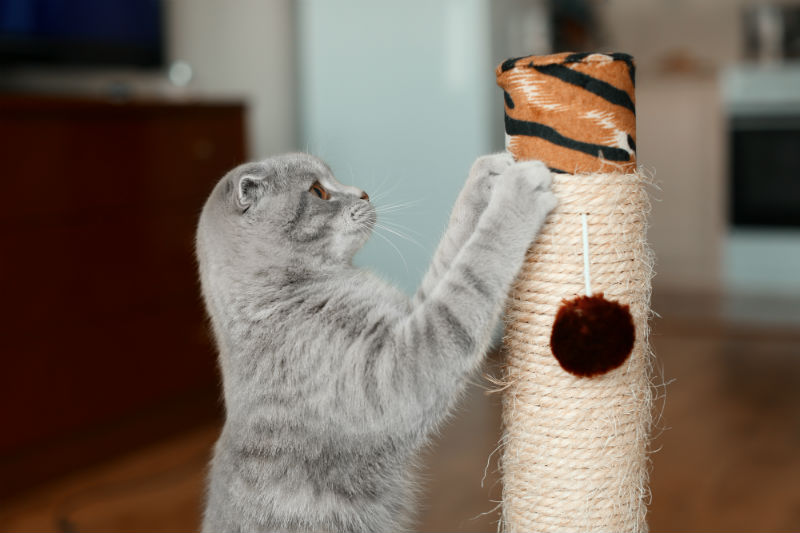Why do cats scratch?
Cats are notorious for their scratching behaviour, which can lead to many destroyed carpets and couches in your home. Many people try to stop the scratching, without understanding the reasons why cats scratch. But trying to stop the behaviour completely, often leads to a lot of frustration for both owners and cats. Scratching is a natural and necessary behaviour for our feline friends. They need to grip with their claws to stretch their paws and do kitty yoga, which feels great and is why they often scratch furniture immediately after waking up from a nap. They need to scratch to remove the older portion of the nail and reveal the sharper points underneath, promoting healthy growth of their nails. They also use their claws to physically and chemically (with pheromones) mark their territory, which means they will scratch more if they feel unsafe or have conflicts with other cats in the house. It’s important to understand the reasons why your kitty loves running their claws through your favourite armchair to convince them that the scratching post is a much better option!
What type of scratching post should you get?
All cats have their own unique personality, so it’s important to get to know them to figure out what type of scratching post they will actually want to use. Some cats love upright posts; some like to stretch out horizontally or at an angle. If your cat likes scratching your carpet, but not your couch, try getting them something that lays flat on the floor. If they like vertical posts make sure, it’s tall enough for them to stand on their back legs and stretch all the way. Make sure the posts are stable, because wobbly posts may fall over and scare your kitty, ensuring that they never touch that post again. Scratching posts can be made out of many different types of materials, so if your cat doesn’t like ones covered in carpet or rope, try one made out of wood or cardboard. Make sure the material is not similar to any other surfaces in your house, because your cat might not know the difference between carpet on the floor and carpet on a post. If you have multiple cats in the house, they might not like the same material, so you may need to get different types of posts for every cat. Cats can be quite territorial, so make sure you have enough posts spread out around the house, so all the kitties have access to a scratching post they like.
Where should you put the scratching post?
The location of the scratching post is very important for your cat, so try moving the post to different areas of the house if your cat won’t use it. They like scratching when they wake up, thus, placing a post near their favourite napping spots will encourage them to use the appropriate surfaces. Put scratching posts as close as possible to the places where your cat is already scratching (like in front of the claw marks in your couch), and reward them when they scratch in the appropriate place. Rewards can include treats, playtime, or petting them. You can attract your cat to a scratching post using treats, catnip, honeysuckle, or attracting sprays you can find in pet stores. They also like marking their territory at doorways and beside windows, so setting up posts in those areas will help them feel satisfied that they’ve claimed that room as their own. Territorial marking is much more common in multi-cat households if some of the cats don’t get along, or if they can see the neighbourhood cats through the window. Stressed cats will mark more often, so be aware of the inter-cat relationships in your home. If you think your cat is scratching more frequently than usual or if they seem stressed, talk to your veterinarian about what could be causing the stress and how to resolve it.
How do you stop your cat from scratching the furniture?
Cats are usually pretty smart, so punishing them with spray bottles or shaking pennies in a can when they’re scratching your couch rarely gets the result you want. Cats will usually associate you with the punishment, so they’ll learn to be scared of you and only scratch your furniture when you’re not around. It’s more effective to deter the cats from scratching by using plastic covers, foil, or double sided tape while placing a post right beside where they want to scratch. You may have to endure the ugly “decorations” for a while until your cat learns to use the scratching post, but once the good behaviour is established, you can take down the plastic covers and very slowly start moving the post to a more desirable area if you need to. Regular nail trims will also help minimize damage; you can learn to do these yourself by watching videos or asking your veterinarian to show you how. Acrylic nail caps will also decrease the amount of damage kitty claws can do, although they do have to be reapplied regularly.
Everyone knows you can’t make a cat do anything it doesn’t want to do, but if you can figure out the type of scratching post your cat likes and have a little patience, you can convince them that the post is a much better claw sharpening tool than your couch.
Written by Alicia Naundorf, RVT (with the information from a Webinar presented by Dr. Enid Stiles).



